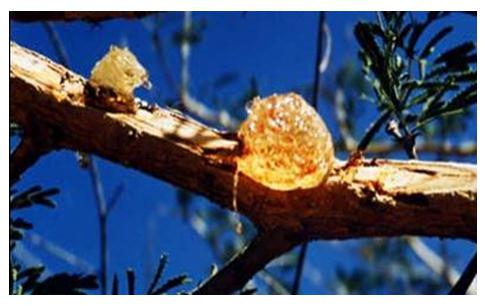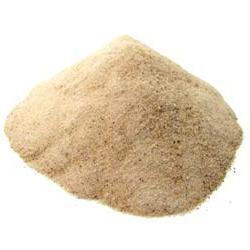Gum arabic (from the Latin gummi - gum, arabikus - Arabian) - Arabian gum, the sticky juice of some types of Arabian acacia, which grows in Africa, India and Australia. The beginning of the production of gum arabic goes back to ancient times. Trees have a height of 3.5 to 4.3 meters. The process of extracting gum is accelerated by applying notches to the bark of the tree, due to which there is a rapid outflow of resin. Next, the "crop" is manually cleaned of pieces of bark. It is completely dissolved in water, forming an adhesive solution. Liquid glue for paper. Gum arabic: what is it? Consider in more detail in the article.
Gum arabic, definition
The following designation is accepted by international standards: stabilizer E 414, or gum arabic e414. Other names: Acacia gum (gum arabic). Belongs to the group of food additives that extend shelf life and improve consumer quality products. The substance is not in the group of hazardous to human health. Gum arabic is widely used and approved for use in Russia, Ukraine and the EU countries. What it is? The photo shows: the substance is similar to amber, and this is not surprising: both are resin of wood.
Characteristics
As we have already found out, they get a food stabilizer from some types of Arabian acacia by manually collecting the resin.
The extracted natural substance is separated from the bark, sorted and purified by refining. Gum arabic enters the market in the form of powder, crystals or amber-colored droplets. The food additive gum arabic has excellent emulsifying and antifoaming properties. It quickly forms a film and gives the liquid a specific texture. It leaves no trace in the cooked dish, while perfectly distributing fats. When boiled, decomposes into simple sugars. It contains huge deposits of fiber. It helps to qualitatively combine incompatible textures, give a certain shape and does not allow the content to delaminate and settle. The use in small doses leaves you feeling full and full of the stomach. Therefore, it is recommended for diet food.
Emulsifier E-414, its functions
Gum arabic: what is it, and why is it so in demand in a variety of industries? Adhesive properties help maintain the shape of the finished product, help to achieve the desired viscosity, contribute to the retention of moisture in bakery products. The same quality does not allow beer to foam in the bottle, perfectly holds the shape of jelly products, does not allow chewing gum to crumble quickly in the mouth. It performs many other functions not available for organic compounds of this category.
Food and Gum Arabic
What is it and where is it used, we have already partially found out. It turns out that sweet tooth would have been deprived of many of the usual desserts, if not for gum arabic. Jelly and marmalade, fruit-based confectionery, gentle homogeneous creams and whipped cream, ice cream would certainly not be so attractive and tasty, if not for gum arabic. The preparation of high-quality dairy, meat and fish semi-finished products and ready-to-eat products is also rarely without this natural substance, an excellent moisture regulator. Fruit and berry yogurts also contain gum arabic. What is this ingredient? It increases the viscosity of the product, maintains the consistency of the finished dishes, gives and retains the shape of the products.
Application in brewing and winemaking
Gum Arabic is involved in the technology of making beer to quench the formation of foam, in winemaking to fix the color of wines.
Non-food use
Dry gum arabic powder is used to create craquels in painting, for the preparation of creative gold and varnish. Immune to organic solvents. The use of gum arabic is associated with the manufacture of ink and watercolors. It is used in lithography, participating in the process of creating clichés, for the preparation of special washing and cleaning solutions for its care (washing clichés for letterpress printing). Widely used in the manufacture of cosmetics: lotions, protective creams. It is used to improve the viscosity of the composition, as the adhesive base is added to cosmetic face masks.
Used in pharmaceuticals to create membranes for tablets, suspensions, emulsions and so on.
It is widely used in cosmetology to create face and body skin care products.
The benefits and harms of gum arabic for the human body
Useful for the absence of allergens. It does not irritate the mucous membranes and the gastrointestinal tract in direct contact with the food supplement. It also copes with the excretion of salts of heavy metals and radionuclides from the body .

The usefulness of the natural product is indicated by the fact that E414 is approved for use in children's and dietetic foods. The property of gum arabic to lower blood glucose is well known due to its high fiber content. It makes it easier for diabetics to fight the disease. Fights cholesterol. Cleans clogged vessels from plaques. Helps in solving problems with the cardiovascular system, lipid metabolism. Helps the stomach work properly, prolonging the digestion of food, and thereby reducing appetite. Qualitatively and quickly helps to lose weight. Gum arabic, which harm still occurs, is contraindicated in people with diseases of the gastrointestinal tract. It is not recommended to exceed the allowable daily intake of a food supplement in an amount of 2 g / kg of a person’s weight.
Conclusion
Gum arabic. What it is? If someone heard this word, then only in any context, in passing. After reading this article, some may recall how they chopped pieces of frozen drips on a cherry trunk and tasted them - a harmless delicacy of a child’s pore. Food gum arabic is very similar to it in both properties and taste.

We learned almost everything about the food supplement E 414, about where it grows and is produced, the functions and characteristics of this product, the scope, benefits and harms of the food supplement. What conclusion can be made? It is practically safe for the human body of any age. Of course, there are contraindications for use, like any other product or medication: everything is good in moderation. Participates in diet and baby food. This means that it is not so harmful if it is used in this industry. We learned that this stabilizer is also used in painting to create paints and fixing agents. In general, as we understood, the scope of its application is vast. Can some acacia resin turn our view on the food industry? What did we know from this area? Almost nothing. Now we are unlikely to forget that there is such a wonderful substance for all occasions.